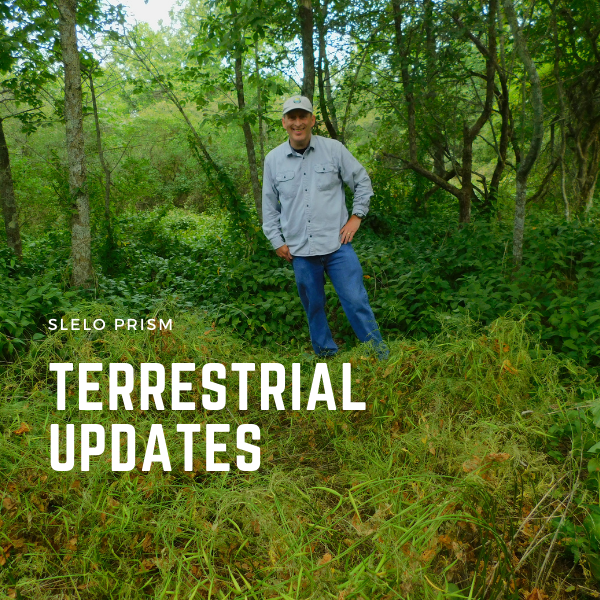This article was featured in the 2022 Spring Newsletter by Robert Smith-SLELO PRISM.
2022 Hemlock Woolly Adelgid (HWA) Survey Results: This year, Team SLELO surveyed 14 sites for HWA. Only one of these sites, Noyes Bird Sanctuary, was found to have HWA present. At this site, five trees were found to have HWA present on its lower leaves. All trees surveyed appeared to be in good health. This sanctuary is owned by the Onondaga Audubon Society and we will be going back with a small group of volunteers to assist them in determining the quantity and size of the trees, and to delineate the hemlock stand. To date HWA has been found at 6 Sites by SLELO PRISM and NYS OPRHP. Sites indicate HWA is progressing up the Lake Ontario shoreline to include: Camp Hollis, Independence Park, Mexico Point State Park, Selkirk Shores SP, Noyes Bird Sanctuary, Oswego County Reforestation Area. The Summary Report should be available soon on the SLELO PRISM website.
Early Detection Surveys remain on a two-year rotation for our Priority Conservation Areas. This year, Brittney and Robert will return to the nine sites surveyed in 2020 to include:
- Black Lake
- Black Pond WMA
- Chaumont Barrens
- Chaumont Bay
- Deer Creek WMA
- El Dorado Preserve
- Lakeview WMA
- Oneida Lake and Three Mile Bay WMA
- Salmon River Estuary
Most of these are both aquatic and terrestrial with a few that are just aquatic or terrestrial. There are several other sites that have never been surveyed and we will visit some of these sites time permitting.


2022 Invasive Species Control Work: As a result of last summer’s early detection surveys and treatments conducted by Miller’s Turf, we retired some treatment areas and added some new sites. This year, we will be treating 12 more sites than last year (26 new sites, 5 retired sites, 9 sites merged into 3 sites, 3 sites inactive/resurveying). Species managed include pale swallow-wort, Japanese knotweed, phragmites, oriental bittersweet, and yellow iris.
As a result of last summer’s early detection surveys and treatments conducted by our licensed subcontractor, we retired some treatment areas and added some new sites. This year, we will be treating 12 more sites than last year (26 new sites, 5 retired sites, 9 sites merged into 3 sites (3 sites inactive/resurveying). Species managed include pale swallow-wort, Japanese knotweed, phragmites, oriental bittersweet, and yellow iris.
As part of SLELO PRISM’s use of integrated pest management, we will also be conducting volunteer hand pulls of swallowwort and yellow iris at certain Priority Conservation Areas (PCAs) where they are present in low numbers with sparse/scattered distribution. The sites involved are Deer Creek WMA, El Dorado Preserve/Black Pond WMA, and Oneida Lake/Three Mile Bay WMA.
Anyone interested in participating should contact Megan Pistolese –Shaw at megan.pistolese@tnc.org.
As part of DEC’s Giant Hogweed Program, we will be monitoring and treating, if necessary, at 44 sites in Lewis and Jefferson counties. To date, giant hogweed has been eradicated (that is free of giant hogweed for three or more years) at 49% of our sites. Of those eradicated sites, 58% involved manual treatment using the root cut method to reduce the use of herbicides.
Biological Controls for Invasive Species Management in SLELO PRISM: Continuing with the theme of using integrated pest management, we have several planned biocontrol releases in the SLELO PRISM Area. Starting with Pale Swallowwort, we will again be releasing Hypena opulenta, the moth that feeds exclusively on swallowwort as larvae. Two cages will be set up at Grenadier Island and two cages will be set up at Wehle State Park. This will occur in early June. Next, we will be releasing three species of parasitoid wasps that target Emerald Ash Borer at Rice Creek Field Station (SUNY Oswego). This will occur from spring through fall and will continue into next year with another series of releases at that location. We are also planning to release two biological control species (a silver fly species and a laricobius beetle), starting in the spring of next year at Independence Park, which is in the heart of where HWA has been found. Lastly, we have noticed an increase in several areas of purple loosestrife. To help control the numbers of this species, we will be releasing Galerucella beetles this year. These beetles are a well-known biocontrol for purple loosestrife and have been used for many years. Our hope with all these biocontrol species releases is that they will establish a population in the area and act as a long-term control for these invasives.
Urban Forest Sustainability Initiative (UFSI): This program is about strategies that increase urban forest resiliency to invasive pests, pathogens, and climate change. We offer participating communities a guide outlining these strategies, a presentation about the program, and up to $5,000 reimbursement for the purchase of non-invasive tree species. The two communities that we are working with are, Utica, which is planning a fall planting, and Ogdensburg, which is currently in early conversations about the program. The only requirements for the reimbursement are that the community allows us to give a presentation about the program and receipts showing the purchase of non-invasive tree species.


